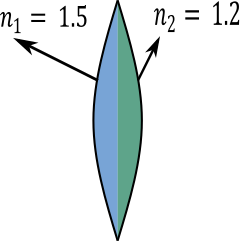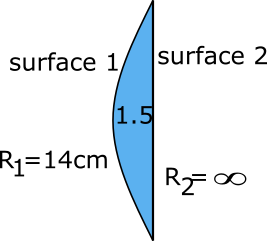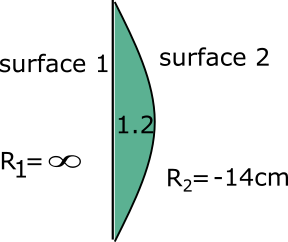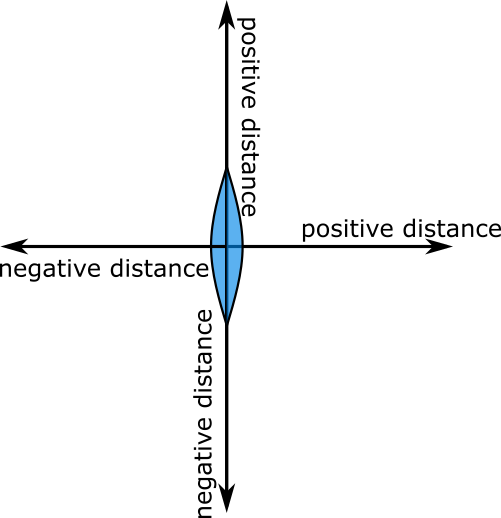Question
Question: A bi-convex lens formed with two thin Plano-convex lenses as shown in the figure. Refractive index o...
A bi-convex lens formed with two thin Plano-convex lenses as shown in the figure. Refractive index of the first lens is 1.5 and that of the second lens is 1.2 both the curved surfaces are of the same radius of curvature R=14cm. For this bi-convex lens, for an object distance of 40cm, the image distance will be.

A) −280.0cm
B) 40.0cm
C) 21.5cm
D) 13.3cm
Solution
We want to find the final position of image for that we must have the focal length of lens only then we can find the position of image. To find the focal length of a lens although we have two Plano-convex lenses, we have to find the focal length of a combination of these Lens. When we find combined focal length then simply we apply lens formula to find the distance of the image.
Complete step by step solution:
In the question the given data is
Radius of curvature of both lanes 14cm and refractive index of lens 1is n1=1.5 and lens 2 is n2=1.2
Step 1: We have to find the individual focal length of both lenses by using formula.
f1=(n−1)(R11−R21) ....................... (1)
Where n⇒ refractive index of lens
And R1⇒ radius of curvature of first surface of lens
R2⇒ Radius of curvature of second surface of lens
f⇒ Focal length of lens
So we apply this formula for the first lens. For first lens

Refractive index n1=1.5
R1=14cm
R2=∞ Because second surface is plane in first lens
Apply formula from eq (1)
⇒f11=(1.5−1)(141−∞1)
⇒f11=(1.5−1)(141)
Solving it
⇒f11=281
So the focal length of lens 1
∴f1=28cm
Similarly we find the focal length of the second lens. For lens 2

Refractive index is n2=1.2
R1=∞
R2=−14cm Because R2 is in left side of optical canter (by sign convention we take left side distance negative in sign and take right side distance positive )
Apply formula from eq(1)
⇒f21=(1.2−1)(∞1−−141)
⇒f21=(1.2−1)(141)
Solving it
⇒f21=701
So focal length of lens 2
f2=70cm
Step 2: In this step we find the focal length of combination of both lenses
We have formula for find equivalent focal length of two lenses is given as
feq1=f11+f21
Using this formula
⇒feq1=281+701
Solving it
⇒feq1=201
So the equivalent focal length of these lenses
∴feq=20cm
Step 3
Now we can find the distance of image by using lens formula
f1=v1−u1
Where u⇒ Distance of object
And v⇒ Distance of image
f⇒ Focal length of lens
In question it is given u=−40cm
f=20cm
Simply apply above formula
⇒201=v1−−401
Rearranging it
⇒v1=201−401
On solving
⇒v1=401
So the distance of image is
∴v=40cm Right side of lens.
Option (B) is correct here.
Note: Some time we get confuse why some time some distances take positive and some take negative so the answer is we use sign convention to understand sign convention see the diagram

We take all distances positive in the right side of the lens and take negative in the left direction.Similarly, in positive y direction take positive height and in negative y direction take negative.
